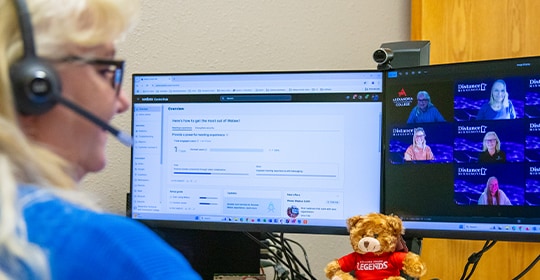Research everything IT
1 - 24 of 118
Sort By:
View:
Jun 27, 2025
Digital Workspace
How CPaaS Improves the Customer Experience
White Paper
13 min
By streamlining customer support channels, Communications Platform as a Service solutions help organizations cut costs and boost consumer satisfaction.
Jun 03, 2025
Digital Workspace
How to Empower Your People With AI
Article
3 min
AI evolution is a revolution for human-centered innovation. Here’s how to put people first in the age of intelligent technology.
Jun 02, 2025
Digital Workspace
SaaS Can Power Productivity When It Matters Most
Article
3 min
With the right support, SaaS productivity solutions empower IT leaders to manage change and emerge stronger on the other side.
May 09, 2025
Digital Workspace
Embracing AI and Cloud Solutions for Optimized Collaboration
Article
5 min
From improving collaboration in virtual meetings to optimizing contact center operations, artificial intelligence and cloud technologies can transform the way your organization works to meet customer needs and business goals seamlessly.
Apr 29, 2025
Digital Workspace
Support and Scale Your Apple Deployment With CDW’s MacOS Advisory Service
Article
3 min
MacOS requires specialized approaches to device management, security configurations and user experience optimization.
Apr 23, 2025
Digital Workspace
2025 Workforce Strategies Every Nonprofit Leader Needs to Know
Article
4 min
Discover essential workforce strategies transforming the nonprofit sector in 2025. From hybrid work to AI-driven hiring, inclusivity and well-being, learn actionable steps to attract, retain and empower talent while driving mission success.
Mar 31, 2025
Digital Workspace
Building a Foundation for Smarter Device Management With Windows 11 Pro Upgrade
Use Case
3 min
During rapid growth, managing devices is no small task. Discover how CDW partnered with a civil engineering and consulting firm to streamline device management, strengthen security and prepare for future expansion, including Windows 11 updates.
Mar 31, 2025
Digital Workspace
A Next-Generation Contact Center Powered by Amazon Connect and ServiceNow
Use Case
3 min
Read how CDW helped a women’s healthcare provider modernize its contact center to enhance call routing efficiency and improve patients’ experience.
Mar 31, 2025
Digital Workspace
Cost-Effective Generative AI Integration in Google Workspace
Article
3 min
Discover how CDW enabled a mortgage company to enhance productivity with Gemini for Google Workspace, delivering seamless integration and securing budget-friendly solutions.
Mar 31, 2025
Digital Workspace
Elevate Your Cybersecurity With CDW Managed Services
Webinar
1 min
Explore how CDW’s new offerings safeguard your business with expert-driven solutions from Microsoft.
Mar 18, 2025
Digital Workspace
Overcoming Common Customer Experience Challenges
Article
4 min
Delivering a seamless and personalized customer experience is no longer optional — it’s a necessity. Read below about a few customer experience challenges your organization might face and how to overcome them strategically.
Mar 11, 2025
Digital Workspace
Thriving in a Work Anywhere Model
Article
4 min
Supporting a distributed workforce has evolved. A successful work anywhere ecosystem today must seamlessly integrate remote and in-person experiences into one cohesive hybrid workplace.
Mar 10, 2025
Digital Workspace
How IT-Friendly Audio Solutions Solve Higher Ed Tech Issues
Article
6 min
Discover how higher education IT leaders can transform audio with easy, high-quality solutions that enhance learning environments, reduce IT burden and improve engagement and accessibility.
Mar 05, 2025
Digital Workspace
The Role of Strategic Implementation in Successful Collaboration
Article
3 min
How stakeholders use the right applications with sufficient knowledge to drive profitable business results should be top priority for your organization. Here are three keys to help boost your collaboration strategically.
Feb 28, 2025
Digital Workspace
How Federal Agencies Can Provide an Optimal Digital Experience
White Paper
11 min
Agencies are focused on modernization, efficiency and cybersecurity as they work to refine and build on their digital transformation initiatives and investments.
Feb 28, 2025
Digital Workspace
Improving Healthcare Efficiency With Azure Virtual Desktop
Article
3 min
A CDW healthcare strategist moderated a discussion on virtualization during the 2025 ViVE conference in Nashville, Tenn.
Jan 17, 2025
Digital Workspace
Giving Employees a Single Source for HR Information and Support
Use Case
3 min
Read how an out-of-the-box (OOTB) solution helped an insurance company transform its employees’ engagement with human resources.
Jan 08, 2025
Digital Workspace
Community College Modernizes Communications by Moving Phones to the Cloud
Case Study
7 min
Alexandria Technical & Community College transitions to Cisco Webex Calling with help from CDW’s higher education team.
Jan 08, 2025
Digital Workspace
3 Cost-Saving Advantages of a Cloud-Based Phone System
Article
2 min
The benefits colleges see from cloud services of all kinds now apply to phone systems as well
Dec 30, 2024
Digital Workspace
4 Best Practices for Working From Anywhere
Article
4 min
Hybrid and remote work are here to stay, and your organization must be positioned to optimize employee productivity in any work environment. Here are some best practices to consider for your mobile workforce.
Nov 18, 2024
Digital Workspace
3 Ways Microsoft Copilot Studio Can Boost Your Productivity
Article
4 min
Microsoft Copilot Studio is a powerful tool for today’s modern workplace. It enables your employees to create virtual agents for internal and external use, boosting their productivity with the help of artificial intelligence.
Nov 04, 2024
Digital Workspace
Utilize AI to Set Industry Standards for Seamless Customer Experience
Article
4 min
For your organization to thrive, your contact center must be optimized to handle the ebb and flow of high demand. With the help of AI, you can elevate your customer experience to the next level.
Nov 01, 2024
Digital Workspace
5 Best Practices for Telecom Expense Management for Global Enterprises
Article
4 min
Having a solid telecom expense management strategy — and partnering with a trusted vendor in this space — are among the keys to elevating the digital experience for all stakeholders and ensuring your organization communicates smarter, not harder.
Oct 31, 2024
Digital Workspace
Navigating the Federal Government's Next Tech Challenge: Windows 11 OS
Article
4 min
Explore the challenges and benefits that Windows 11 will bring to federal agencies.

























